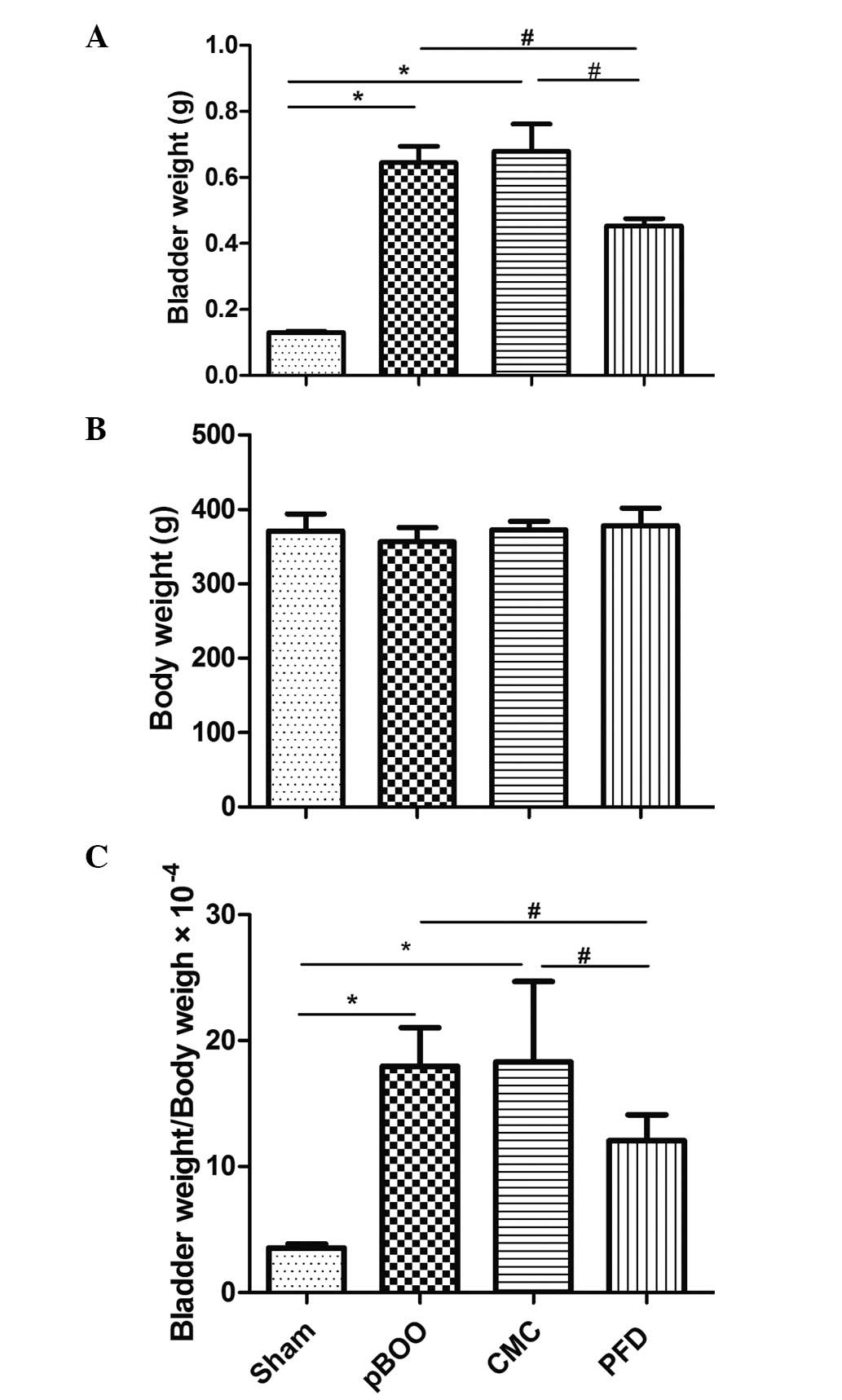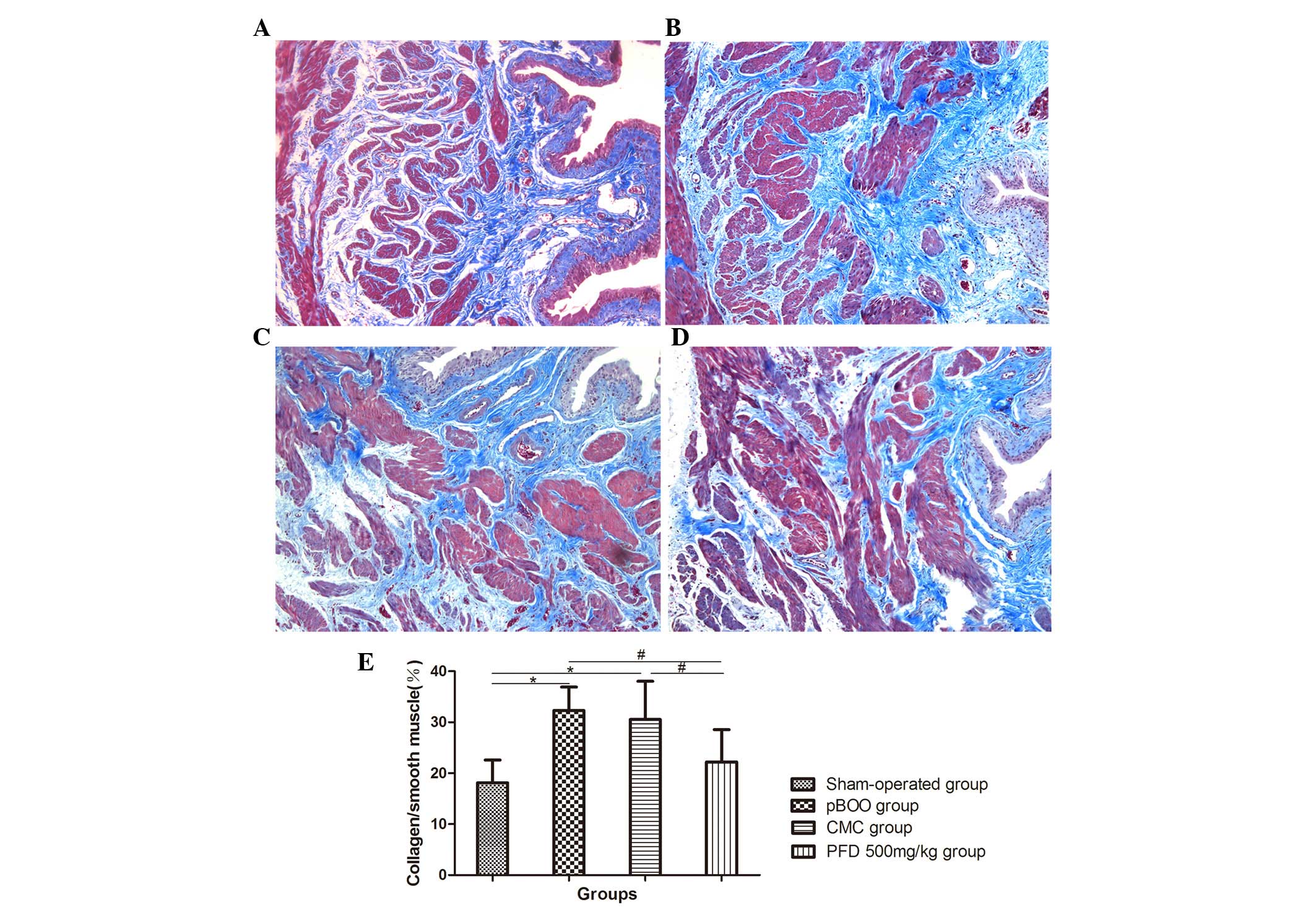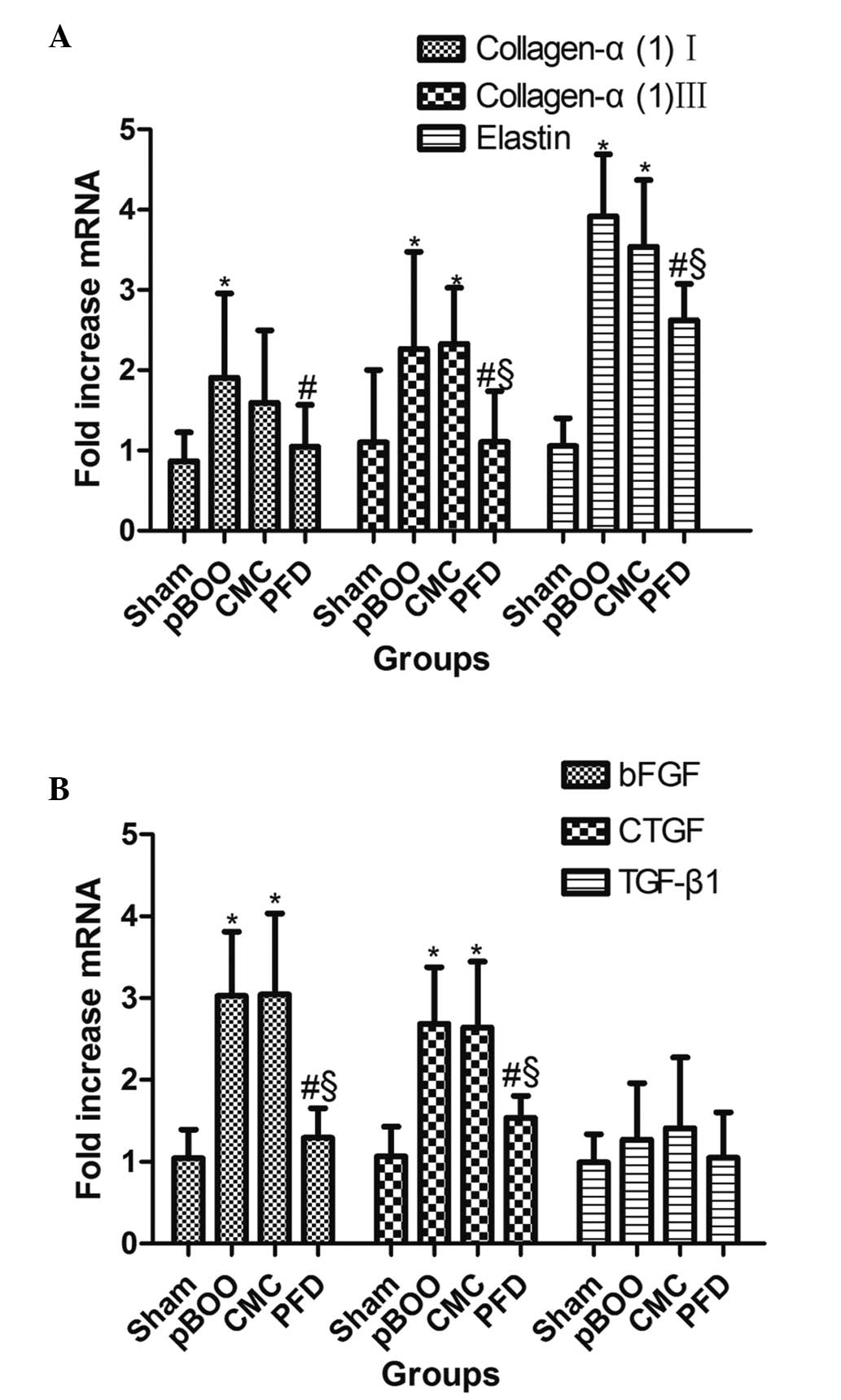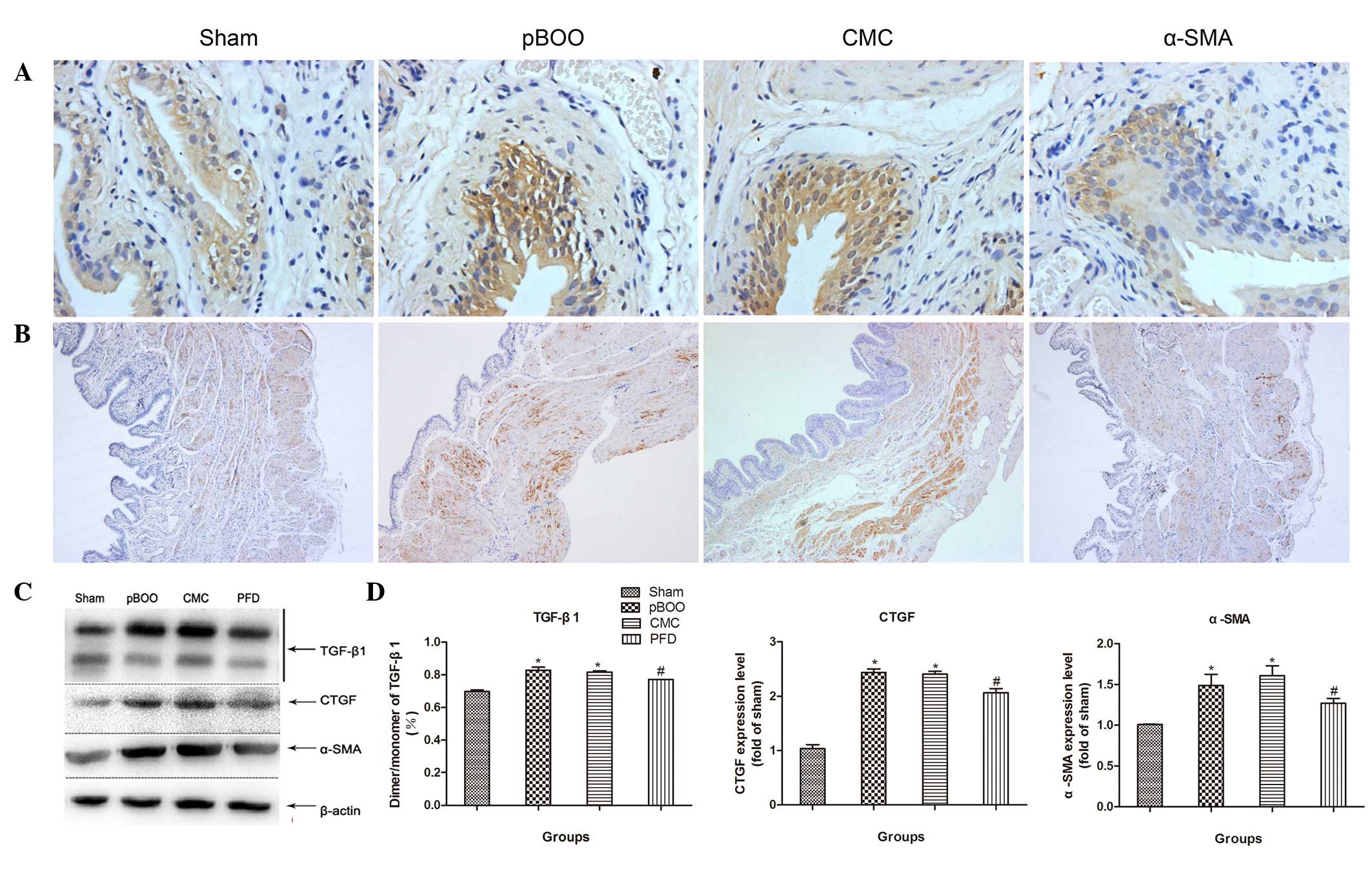|
1
|
Metcalfe PD, Wang J, Jiao H, et al:
Bladder outlet obstruction: progression from inflammation to
fibrosis. Bju Int. 106:1686–1694. 2010. View Article : Google Scholar : PubMed/NCBI
|
|
2
|
Baskin LS, Sutherland RS, Thomson AA, et
al: Growth factors and receptors in bladder development and
obstruction. Lab Invest. 75:157–166. 1996.PubMed/NCBI
|
|
3
|
Kim JC, Yoon JY, Seo SI, et al: Effects of
partial bladder outlet obstruction and its relief on types I and
III collagen and detrusor contractility in the rat. Neurourol
Urodyn. 19:29–42. 2000. View Article : Google Scholar
|
|
4
|
Kaplan EP, Richier JC, Howard PS, et al:
Type III collagen messenger RNA is modulated in non-compliant human
bladder tissue. J Urol. 157:2366–2369. 1997. View Article : Google Scholar : PubMed/NCBI
|
|
5
|
Wick G, Backovic A, Rabensteiner E, et al:
The immunology of fibrosis: innate and adaptive responses. Trends
Immunol. 31:110–119. 2010. View Article : Google Scholar : PubMed/NCBI
|
|
6
|
Iyer SN, Margolin SB, Hyde DM and Giri SN:
Lung fibrosis is ameliorated by pirfenidone fed in diet after the
second dose in a three-dose bleomycin-hamster model. Exp Lung Res.
24:119–132. 1998. View Article : Google Scholar : PubMed/NCBI
|
|
7
|
Kehrer JP and Margolin SB: Pirfenidone
diminishes cyclophosphamide-induced lung fibrosis in mice. Toxicol
Lett. 90:125–132. 1997. View Article : Google Scholar : PubMed/NCBI
|
|
8
|
Azuma A, Nukiwa T, Tsuboi E, et al:
Double-blind, placebo-controlled trial of pirfenidone in patients
with idiopathic pulmonary fibrosis. Am J Respir Crit Care Med.
171:1040–1047. 2005. View Article : Google Scholar : PubMed/NCBI
|
|
9
|
Navarro-Partida J, Martinez-Rizo Ab,
Gonzalez-Cuevas J, Arrevillaga-Boni G, Ortiz-Navarrete V and
Armaendariz-Borunda J: Pirfenidone restricts Th2 differentiation in
vitro and limits Th2 response in experimental liver fibrosis. Eur J
Pharmacol. 678:71–77. 2012. View Article : Google Scholar : PubMed/NCBI
|
|
10
|
García L, Hernández I, Sandoval A, et al:
Pirfenidone effectively reverses experimental liver fibrosis. J
Hepatol. 37:797–805. 2002. View Article : Google Scholar : PubMed/NCBI
|
|
11
|
Chen JF, Ni HF, Pan MM, et al: Pirfenidone
inhibits macrophage infiltration in 5/6 nephrectomized rats. Am J
Physiol Renal Physiol. 304:F676–F685. 2013. View Article : Google Scholar
|
|
12
|
Shi Q, Liu X, Bai Y, et al: In vitro
effects of pirfenidone on cardiac fibroblasts: Proliferation,
myofibroblast differentiation, migration and cytokine secretion.
PLoS One. 6:e281342011. View Article : Google Scholar : PubMed/NCBI
|
|
13
|
Armaendariz-Borunda J, Lyra-Gonzalez I,
Medina-Preciado D, et al: A controlled clinical trial with
pirfenidone in the treatment of pathological skin scarring caused
by burns in pediatric patients. Ann Plast Surg. 68:22–28. 2012.
View Article : Google Scholar
|
|
14
|
Zhao XY, Zeng X, Li XM, et al: Pirfenidone
inhibits carbon tetrachloride- and albumin complex-induced liver
fibrosis in rodents by preventing activation of hepatic stellate
cells. Clin Exp Pharmacol Physiol. 36:963–968. 2009. View Article : Google Scholar : PubMed/NCBI
|
|
15
|
Iyer SN, Gurujeyalakshmi G and Giri SN:
Effects of pirfenidone on transforming growth factor-beta gene
expression at the transcriptional level in bleomycin hamster model
of lung fibrosis. J Pharmacol Exp Ther. 291:367–373.
1999.PubMed/NCBI
|
|
16
|
Liu F, Yao L, Yuan J, et al: Protective
effects of inosine on urinary bladder function in rats with partial
bladder outlet obstruction. Urology. 73:1417–1422. 2009. View Article : Google Scholar : PubMed/NCBI
|
|
17
|
Kim JW, Jang HA, Bae JH and Lee JG:
Effects of coenzyme Q10 on bladder dysfunction induced by chronic
bladder ischemia in a rat model. J Urol. 189:2371–2376. 2013.
View Article : Google Scholar : PubMed/NCBI
|
|
18
|
Oku H, Shimizu T, Kawabata T, et al:
Antifibrotic action of pirfenidone and prednisolone: different
effects on pulmonary cytokines and growth factors in
bleomycin-induced murine pulmonary fibrosis. Eur J Pharmacol.
590:400–408. 2008. View Article : Google Scholar : PubMed/NCBI
|
|
19
|
Parekh A, Long RA, Chancellor MB and Sacks
MS: Assessing the effects of transforming growth factor-beta1 on
bladder smooth muscle cell phenotype. II Modulation of collagen
organization. J Urol. 182:1216–1221. 2009. View Article : Google Scholar : PubMed/NCBI
|
|
20
|
Cortivo R, Pagano F, Passerini G, et al:
Elastin and collagen in the normal and obstructed urinary bladder.
Br J Urol. 53:134–137. 1981. View Article : Google Scholar : PubMed/NCBI
|
|
21
|
Ewalt DH, Howard PS, Blyth B, et al: Is
lamina propria matrix responsible for normal bladder compliance? J
Urol. 148:544–549. 1992.PubMed/NCBI
|
|
22
|
Djavan B, Lin V, Kaplan EP, et al:
Decreased elastin gene expression in noncompliant human bladder
tissue: a competitive reverse transcriptase-polymerase chain
reaction analysis. J Urol. 160:1658–1662. 1998. View Article : Google Scholar : PubMed/NCBI
|
|
23
|
Toosi KK, Nagatomi J, Chancellor MB and
Sacks MS: The effects of long-term spinal cord injury on mechanical
properties of the rat urinary bladder. Ann Biomed Eng.
36:1470–1480. 2008. View Article : Google Scholar : PubMed/NCBI
|
|
24
|
Bai J, Liu XS, Xu YJ, Zhang ZX, Xie M and
Ni W: Extracellular signal-regulated kinase activation in airway
smooth muscle cell proliferation in chronic asthmatic rats. Sheng
Li Xue Bao. 59:311–318. 2007.PubMed/NCBI
|
|
25
|
Schultz K, Murthy V, Tatro JB and Beasley
D: Endogenous interleukin-1 alpha promotes a proliferative and
proinflammatory phenotype in human vascular smooth muscle cells. Am
J Physiol Heart Circ Physiol. 292:H2927–H2934. 2007. View Article : Google Scholar : PubMed/NCBI
|
|
26
|
Runyan CE, Poncelet AC and Schnaper HW:
TGF-beta receptor-binding proteins: complex interactions. Cell
Signal. 18:2077–2088. 2006. View Article : Google Scholar : PubMed/NCBI
|
|
27
|
Leask A and Abraham DJ: TGF-beta signaling
and the fibrotic response. FASEB J. 18:816–827. 2004. View Article : Google Scholar : PubMed/NCBI
|
|
28
|
Howard PS, Kucich U, Coplen DE and He Y:
Transforming growth factor-beta1-induced hypertrophy and matrix
expression in human bladder smooth muscle cells. Urology.
66:1349–1353. 2005. View Article : Google Scholar : PubMed/NCBI
|
|
29
|
Barendrecht MM, Mulders AC, van der Poel
H, et al: Role of transforming growth factor beta in rat bladder
smooth muscle cell proliferation. J Pharmacol Exp Ther.
322:117–122. 2007. View Article : Google Scholar : PubMed/NCBI
|
|
30
|
Schaefer CJ, Ruhrmund DW, Pan L, et al:
Antifibrotic activities of pirfenidone in animal models. Eur Respir
Rev. 20:85–97. 2011. View Article : Google Scholar : PubMed/NCBI
|
|
31
|
Salazar-Montes A, Ruiz-Corro L,
López-Reyes A, et al: Potent antioxidant role of pirfenidone in
experimental cirrhosis. Eur J Pharmacol. 595:69–77. 2008.
View Article : Google Scholar : PubMed/NCBI
|
|
32
|
Oku H, Nakazato H, Horikawa T, et al:
Pirfenidone suppresses tumor necrosis factor-alpha, enhances
interleukin-10 and protects mice from endotoxic shock. Eur J
Pharmacol. 446:167–176. 2002. View Article : Google Scholar : PubMed/NCBI
|
|
33
|
Tada S, Nakamuta M, Enjoji M, et al:
Pirfenidone inhibits dimethylnitrosamine-induced hepatic fibrosis
in rats. Clin Exp Pharmacol Physiol. 28:522–527. 2001. View Article : Google Scholar : PubMed/NCBI
|
|
34
|
Simone NL, Soule BP, Gerber L, et al: Oral
pirfenidone in patients with chronic fibrosis resulting from
radiotherapy: a pilot study. Radiat Oncol. 2:192007. View Article : Google Scholar : PubMed/NCBI
|
|
35
|
Walker JE, Giri SN and Margolin SB: A
double-blind, randomized, controlled study of oral pirfenidone for
treatment of secondary progressive multiple sclerosis. Mult Scler.
11:149–158. 2005. View Article : Google Scholar : PubMed/NCBI
|
|
36
|
Alcántar-Díaz BE, Gómez-Meda BC,
Zúñiga-González GM, et al: Genotoxic evaluation of pirfenidone
using erythrocyte rodent micronucleus assay. Food Chem Toxicol.
50:2760–2765. 2012. View Article : Google Scholar : PubMed/NCBI
|
|
37
|
Pandita RK, Fujiwara M, Alm P and
Andersson KE: Cystometric evaluation of bladder function in
non-anesthetized mice with and without bladder outlet obstruction.
J Urol. 164:1385–1389. 2000. View Article : Google Scholar : PubMed/NCBI
|













